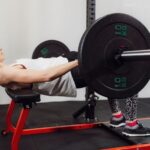
Best Exercises to Target Your Posterior Deltoid Muscles
Page Contents
- Rows for Your Shoulders
- The Push Press
- How to Incorporate Lunges
- Targeting With Plyo Push-Ups
- Reverse Flys to Increase Range of Motion
- Target the Rotator Calf Muscles
- Building Strength With Pulls
- Building Stability With Band Pulls
- Challenging Yourself With Dumbbell Bench Rows
- Final Words – Best Exercises to Target Your Posterior Deltoid Muscles
Today, working on overall shoulder strength is vital if you want to get the most out of your physical activity. No matter what your current fitness level, targeting your posterior deltoids can make all the difference in strength, performance, and even appearance. But how do you find the best exercises to target these muscles?
Let’s start by looking at why posterior deltoids are so important. The posterior deltoids literally play a huge role in giving your shoulders a more “full” appearance. They act as a stabilizer muscle, which can decrease your risk of strain and balance out the muscle development of your shoulder area.
In addition, exercises that target your posterior deltoids can improve muscle control as you move through multiple planes of movement. With stronger posterior deltoids, you can develop greater flexibility and control your shoulder more effectively. As you strengthen your posterior deltoids, you can improve shoulder performance in any number of sports and physical activities.
Now that you know why the posterior deltoids are so important, it’s time to find out which exercises work best to target those muscles. One of the best-known exercises for targeting posterior deltoids is the reverse fly. This exercise involves holding a weight in each hand and lifting them out to your sides while squeezing your shoulder blades together. Make sure to keep your elbows slightly bent and your hands straight. This will help you maximize your shoulder muscles while increasing your range of motion.
Another excellent exercise for targeting the posterior deltoids is the bent-over lateral raises. This exercise requires you to stand with a slight bend in your knees and hinge forward at your hips, keeping your back straight. Then hold a weight in each hand, with your arms extended and bend the elbows to 90 degrees. While keeping your arms as straight as possible throughout the movement, raise your arms out to the side. This will lead to a great activation of the shoulder muscles.
Finally, you can incorporate upper-body plyometric exercises to bolster your posterior deltoids. Plyometric exercises involve explosive movement, such as clapping or jumping on a box or in place, and can help target your posterior deltoids with more intensity.
Rows for Your Shoulders
One of the most overlooked exercises for targeting the posterior deltoids is the row. Rows involve bringing a weight up to your chest while squeezing your shoulder blades together. This exercise targets the back-part of the deltoids that provide so much control and stability to the shoulder area.
There are many different types of row exercises that target the posterior deltoids, including seated cable rows, single-arm dumbbell rows and barbell rows. To maximize your results, keep your hips steady and your chest upright, and focus on driving the elbows back. Make sure to use proper form to avoid any chances of injury.
If you are having difficulty performing rows with external weight, bodyweight rows can be a great starting point to get the hang of the movement and learn how to properly engage your shoulder muscles. They can also be easily modified as you strength your posterior deltoids.
The Push Press
The push press is another great exercise for the posterior deltoids. It involves pushing a weight overhead while squeezing your shoulder blades and activating your core for stability.
To perform the push press, begin by getting into a standing position with a weight in front of you. Then, explosively dip down and use your legs and core to propel the weight straight up and overhead. As you push upward, bring your arms back slightly to engage your posterior deltoids.
This exercise is ideal for people of all levels, offering an explosive movement which leads to increased shoulder strength and great activation of the posterior deltoids. It is also a great way to increase power and muscle coordination.
How to Incorporate Lunges
Lunges are often overlooked when it comes to strengthening your posterior deltoids, but they should not be underestimated! This simple exercise can help target the muscles deep in your shoulder and back.
To perform this exercise, start by standing straight with a weight held in your hands. Keep your arms close to your sides throughout the exercise. You can do either alternating lunges or step lunge, depending on what you prefer. During the lunge, make sure to keep your torso upright and your chest in line with your hips, and drive the weight in a circular motion. This motion will help to engage your posterior deltoids more.
Lunges are a great way to increase your shoulder stability and strength while also targeting the posterior deltoids. You can easily incorporate them into their workouts by adding a few sets and reps at the end of their routine.
Targeting With Plyo Push-Ups
Another great way to target the posterior deltoids is by performing plyo push-ups. This exercise is similar to the push press but incorporates elements of plyometrics. To do this exercise, begin in the push-up position and lower your body to the ground. Then explosively drive up, pushing your body off the ground and clapping your hands together in mid-air. At the same time, make sure to squeeze your shoulder blades together and drive your elbows slightly back to maximize the activation of your posterior deltoids.
This exercise can help increase muscle strength and agility while also target your posterior deltoids. It is great for people of all levels and can easily be modified to make it more challenging. Try adding weight or reducing your break time to increase the intensity.
Reverse Flys to Increase Range of Motion
The traditional reverse flies are a great way to increase your posterior deltoid strength and range of motion. Reverse flys involve holding a weight in each hand and lifting them out to the side, making sure to squeeze your shoulder blades together.
By performing reverse flys with correct form, you can increase your strength in your posterior deltoids. At the same time, because of the positioning of the arms, this exercise can strengthen the muscles around the shoulder blade and increase your shoulder stability.
Overall, reverse flys are a great option for anyone looking to target their posterior deltoids. Make sure to use a weight that is appropriate for your abilities and keep your form intact throughout the exercise.
Target the Rotator Calf Muscles
The rotator cuff muscles are essential for shoulder stability and movement. Strengthening and targeting these muscles will help ensure optimal shoulder stability, especially for athletes.
One of the best exercises for targeting the rotator cuff muscles is the external rotation. This exercise is performed seated with your elbow against your side and a weight in your hand. Begin by rotating your arm upward and outward, focusing on squeezing the muscles at the back of your shoulder. Make sure to keep your elbow locked in position and your shoulder blade pressed against the wall.
By incorporating the exercises we discussed above, you can increase the strength of your posterior deltoids and rotator cuff muscles. Additionally, you can maximize your shoulder development and control. Although each exercise that we covered is important for overall shoulder strength, it is important to listen to your body and make sure you’re not overtraining. Take your time and make sure to rest and recover between workouts.
Building Strength With Pulls
Pulls are one of the best exercises for targeting the posterior deltoids and are a great addition to any upper-body workout. They involve the same basic motions as a row, but with a slightly different execution.
To perform this exercise, begin by standing with your feet shoulder-width apart. Then, pull the weight in towards your chest while squeezing your shoulder blades. As you pull, make sure to keep your elbows close to your body and your arms at a 90-degree angle. Keep your chest and torso upright and use your core to help maintain balance and control.
This exercise is a great way to increase posterior deltoid strength, shoulder stability, and coordination. Pulls can be easily modified depending on your current fitness level and should be incorporated into any workout program.
Building Stability With Band Pulls
Another great exercise for targeting the posterior deltoids is the band pull. This exercise involves standing with your feet shoulder-width apart and holding onto an exercise band. Then, pull the band out to the sides, bringing your shoulder blades together.
This exercise is great for strengthening and stabilizing your shoulder muscles, as the band provides resistance throughout the whole movement. It is also great for targeting the posterior deltoids in a safe and effective way.
Additionally, band pulls are a great way to increase shoulder stability and coordination as the resistance is always present throughout the entire movement. Try adding band pulls into your routine and incorporate different levels of resistance to challenge yourself.
Challenging Yourself With Dumbbell Bench Rows
Dumbbell bench rows are an excellent exercise for targeting the posterior deltoids and a great way to challenge yourself. To perform this exercise, begin by lying flat on a bench with a weight in each hand. Then, keeping your hips steady, explosively drive your elbows back towards your sides. Make sure to keep your elbows close to your body throughout the movement.
This exercise is great for building strength in the posterior deltoids and increasing shoulder stability. It is also a great exercise for challenging yourself, as the explosive movement helps to maximize muscle activation. As you get stronger, make sure to add more weight or reps to make the exercise more challenging.
All in all, targeting your posterior deltoid muscles is vital for overall shoulder strength and development. Remember to take your time and make sure to use proper form throughout all exercises. Additionally, make sure to rest and recover between workouts and incorporate other movements as well. Now is the time to get started and make your posterior deltoids stronger and more stable!
Final Words – Best Exercises to Target Your Posterior Deltoid Muscles
In conclusion, understanding the importance of posterior deltoid exercises is key to unlocking your full shoulder potential. These exercises not only enhance the appearance of your shoulders but also contribute to overall strength, stability, and improved performance in various physical activities.
Your posterior deltoids play a crucial role in shoulder aesthetics and function by acting as stabilizer muscles. Strengthening them not only balances your shoulder muscle development but also reduces the risk of strain. Additionally, targeting these muscles improves your ability to control shoulder movement in different planes, enhancing flexibility and performance in sports and daily activities.
To effectively target the posterior deltoids, several exercises are highly recommended:
1. Reverse Fly: This classic exercise involves lifting weights out to your sides while squeezing your shoulder blades together. Maintaining a slight elbow bend and straight hands maximizes muscle engagement and range of motion.
2. Bent-Over Lateral Raises: With a slight knee bend and a straight back, lift weights with bent elbows to 90 degrees, then raise your arms out to the sides. This motion activates the posterior deltoids effectively.
3. Rows: Rows, including seated cable rows, single-arm dumbbell rows, and barbell rows, involve pulling weights toward your chest while squeezing your shoulder blades. Focus on driving your elbows back while maintaining proper form for optimal results.
4. Push Press: This dynamic exercise engages the posterior deltoids as you push weights overhead while activating your core for stability. It’s suitable for individuals of all fitness levels and enhances shoulder strength, coordination, and power.
5. Lunges: Although often overlooked for posterior deltoid strengthening, lunges can target the deep shoulder and back muscles. Maintain an upright torso and drive the weights in a circular motion to engage the posterior deltoids more effectively.
6. Plyo Push-Ups: Combining elements of plyometrics with traditional push-ups, plyo push-ups involve explosive movements and clapping in mid-air. Squeezing your shoulder blades and driving your elbows slightly back intensifies posterior deltoid activation.
7. Rotator Cuff Exercises: External rotation exercises, such as those involving weights and a wall for support, strengthen the rotator cuff muscles, which are vital for shoulder stability and movement.
Incorporating these exercises into your workout routine can significantly boost your posterior deltoid strength, shoulder stability, and overall control. However, it’s essential to prioritize proper form, listen to your body, and allow for adequate rest and recovery between workouts. Strengthening these muscles will not only enhance your shoulder aesthetics but also contribute to better overall shoulder health and performance.




